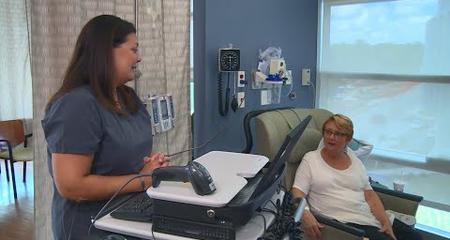An accurate brain and spine tumor diagnosis provides the best treatment plan. Our team looks at your tumor from different angles, using advanced imaging techniques and analysis of your tumor cells to determine the specific type of tumor and the best treatment.
Imaging for Diagnosis and a Treatment Plan
You might have had a computed tomography (CT) scan or magnetic resonance imaging (MRI) when the doctors initially found your tumor. Beyond the initial discovery, standard imaging techniques don’t provide enough information — such as the location of a brain tumor in relation to areas that control motor function and speech. When a tumor is lodged in the spine, for example, doctors need to know if it is part of the bone in the vertebrae, the dura (a layer protecting the spinal cord) or the fibers of the spinal cord itself.
A precise view of areas to treat — and areas to avoid — is critical. Froedtert & MCW brain and spine tumor specialists use high-resolution imaging techniques for maximum tumor control with minimum impact to a patient’s normal functions. Imaging is incorporated in every phase of the patient experience from diagnosis to planning and treatment with surgery, radiation therapy and drug therapy. Imaging also tells us if a patient’s tumor is responding well to chemotherapy or other drug therapies.
We also use sophisticated imaging to monitor your progress or to see when tumors are starting to grow before they can be seen with standard magnetic resonance (MRI) and before patients experience symptoms. Our biophysicists are pioneers in bringing new techniques into standard practice. An example is MR perfusion or rCBV (relative cerebral blood volume), a way of using MRI to pinpoint brain areas where new blood vessels are growing and increased blood flow indicates tumor growth.
Getting accurate images followed by a neuroradiologist’s analysis (a radiologist who specializes in the central nervous system) are among first steps directing treatment. You may go to a doctor with disruptive symptoms that could include headache, visual problems, nausea, pain or problems walking — or you may go to the emergency department because your symptoms are sudden or severe, needing immediate attention. Ultimately, the neuroradiologist reviews imaging results in our weekly brain and spine tumor board meeting, where an entire team of brain and spine experts from different areas (radiology, surgery, radiation oncology, medical oncology, pathology and biophysics) evaluates your case and makes recommendations about treatment.
MRI for Brain Tumor Imaging
MRI is a mainstay for brain tumor diagnosis, treatment planning and monitoring. Neuroradiologists use several highly specialized MRI techniques, including the following.
- Functional MRI (fMRI): fMRI measures and maps brain activity. It shows how a brain tumor affects your normal functions by measuring minute changes in blood flow that happen with brain activities, and it can verify which parts of the brain are controlling critical functions. fMRI can be used to detect abnormalities that can’t be found with other imaging techniques and to guide treatments like surgery and radiation therapy. This technique will also tell the treatment team if a tumor is growing.
- MRI with diffusion tensor imaging (DTI): DTI measures the rate of water diffusion between cells to create a map of the brain. This map reveals white matter pathways and how close they are to the tumor. Having a white matter pathway “map” is valuable to the surgeon for planning the surgical approach that will remove the most tumor tissue with the least risk to the patient. A neuropsychologist also uses the information before surgery to see where speech, language and motor functions are controlled.
White matter, found in the deep tissues of the brain, contains bundles of nerve fibers that are extensions of nerve cells (neurons) that control certain functions. As white matter weaves in and out of gray matter (primarily made up of neurons), it forms an intricate network that connects the brain’s hemispheres and fires up conscious thought – much like the wiring behind the walls of your house that controls light fixtures and other devices that run on electricity.
- MR spectroscopy (MRS): Spectroscopy is a series of tests that are added to an MRI scan to help identify a mass that could be a new tumor, tumor recurrence or progression. This complex technique looks at abnormalities in brain tissue at the cellular level, measuring the chemical metabolism of the cells of a mass in comparison to healthy brain tissue. With MRS, the neuroradiologist can determine what sort of activity is happening. A certain pattern of metabolites (small molecules) may suggest a tumor or other inflammatory process.
MR Perfusion Imaging and Nuclear Medicine Imaging Techniques
When diagnosing or monitoring brain tumors and monitoring after treatment, it is sometimes difficult to determine if a bright spot on the images represents tumor tissue or “treatment effect” — inflammation of brain tissue following treatment. Techniques that will help to characterize the nature of tissue changes include MR perfusion imaging and nuclear medicine techniques like positron emission tomography (PET).
- Perfusion imaging, a specialized MRI method, shows the distribution of blood vessels in brain and tumor tissue. Since tumors need to generate more blood vessels to grow, perfusion MRI can provide information to track tumor growth and response to treatment.
- Nuclear medicine is a specialty within radiology that includes collecting images with a PET scanner. It uses tiny amounts of radioactive materials called tracers that are absorbed by brain tissue. These tracers can appear as hot or bright spots indicating more activity in an area or cold spots indicating less activity.
- PET scan images can also be used for diagnosis, detecting tumor growth or follow-up after treatment to determine if the treatment is working.
MRI, CT and PET for Spine Tumor Imaging
Computed tomography (CT) and standard MRI are both used for diagnosing spine tumors, following up to check on effectiveness of treatment and monitoring for tumor growth. These techniques can tell the surgeon or radiation oncologist how much of a tumor they can remove or treat without significant damage to the spine.
CT uses X-rays to examine changes to the bone structure of the spine, while MRI shows more detail of the spinal cord, nerve roots and tissues, including tumor tissue. Positron emission tomography (PET) scans are used for surveillance follow-up and distinguishing malignant transformation of benign tumors.
Neuropathology
After a complete medical exam that includes neurological exams and imaging, your doctor will work with other experts to form a complete diagnosis. Evaluating your tumor right down to the cellular level provides the most accurate diagnosis possible to aid in treatment planning and monitoring after treatment.
In the Brain and Spine Tumor Program, neuropathologists play a critical role in treatment planning. General pathologists interpret tissue analysis from a variety of different tumors like tumors of the breast, prostate gland, lungs and other areas. A neuropathologist focuses only on interpreting central nervous system abnormalities in brain or spinal cord tissue samples. This is all they do; therefore, they have deep knowledge about central nervous system tumors and are current on the latest techniques for analyzing them.
Our neuropathologists examine tissues removed during surgery and determine the kind of tumor present. This group of experts studies your particular brain or spine tumor’s characteristics; your medical history; and current condition to ensure they have an accurate diagnosis.
Molecular Analysis
Based on that unique information, they will decide what type of molecular assay is needed to guide your treatment. A molecular assay is a lab test of samples of your tissue, blood or body fluid to find out if certain genes, proteins or other molecules are present. It also checks for common changes in genes or chromosomes to classify your tumor type. Usually, your tumor cells will show a predictable genetic change — a molecular “signature” that is typical of a specific type of tumor. For instance, a brain tumor called an oligodendroglioma is a type of glioma that always has certain chromosome abnormalities.
The neuropathologist’s diagnosis and the results of the molecular analysis are shared and discussed with your treatment team. A molecular test is an important component in helping your treatment team create your most effective treatment plan. Treatment will always include the standard of care defined for your particular type of tumor. In addition, changes found in the molecular test will give your team important pieces of information that will influence your treatment and may help predict your prognosis — how well you will do with treatment and beyond.
- If there are no significant gene or other cell changes, you are a candidate for standard treatment.
- If changes found in your genes are known to be hereditary, you would benefit from an appointment with a genetic counselor.
- A particular clinical trial may be your best treatment.
- Your best option may include a drug that is FDA-approved to treat a different disease but could be effective against your cancer.
Virtual Visits Are Available
Safe and convenient virtual visits by video let you get the care you need via a mobile device, tablet or computer wherever you are. We’ll gather your medical records for you and get our experts’ input so we can offer treatment options without an in-person visit. To schedule a virtual visit, call 1-866-680-0505.
More to Explore





